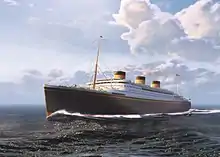Oceanic (unfinished ship)
The RMMV Oceanic (Royal Mail Motor Vessel) was the planned name of an unfinished ocean liner that was partially built by Harland and Wolff for the White Star Line. The ship was to have been the first 1,000-foot (300 m)-long ocean liner.
 Digital drawing by Anton Logvynenko of the planned ocean liner RMMV Oceanic (III) | |
| History | |
|---|---|
| Name: | RMMV Oceanic |
| Owner: | White Star Line (intended) |
| Operator: | White Star Line (intended) |
| Ordered: | 18 June 1928 |
| Builder: | Harland and Wolff, Belfast (keel laid only) |
| Yard number: | 844 |
| Laid down: | 28 June 1928 |
| Fate: | Construction halted on 23 July 1929; cancelled 1930 |
| General characteristics | |
| Tonnage: | 60,000 - 80,000 GRT (estimated) |
| Length: | 1,050 ft (320.0 m) (intended) |
| Beam: | 120 ft (36.6 m) (estimated) |
| Draught: | 38 ft (11.6 m) (intended) |
| Decks: | 12 (intended) |
| Installed power: | Diesel-electric drive; 47 six-cylinder, exhaust turbo-charged, four-stroke, single-acting diesel generators; 275,000 IHP (200,000 SHP) |
| Propulsion: | Quadruple screws |
| Speed: | 28.5 knots (52.8 km/h; 32.8 mph) (service speed); 30 knots (56 km/h; 35 mph) (max. speed) |
History
Several sets of plans for the ship's design were produced by Harland and Wolff for Oceanic between 1926 and 1930. One set, submitted in January 1926, showed a 900-foot (270 m)-long four-funnel liner. Another set, drawn later the same year, showed a 935 feet long and 100 feet wide liner with three funnels. It was roughly the same size as Europa and Bremen. The final set showed the current 1,050-foot-long (320 m) design with three funnels and cruiser stern typical of liners being built in the mid to late 1920s.

The order was placed on 18 June 1928 and construction began on 28 June 1928, when her keel was laid. The work was slowed by a dispute over her powerplant; Lord Kylsant who controlled the White Star Line wanted to use diesel-electric instead of the then more common steam power. White Star proposed having over 40 diesel generator sets driving four propellers through geared electric motors. Harland & Wolff was reluctant to adopt this system, preferring to continue the use of trusted steam turbine propulsion. A compromise of sorts was reached and the final design used four conventional low-speed 'cathedral' diesel engines, each directly driving one propeller shaft - which would have made Oceanic the first quadruple-screw Motor ship. But by the time all parties had settled on the use of diesel, the Great Depression was hitting the shipping business.
Cancellation

Further work on Oceanic was postponed, and later cancelled due to the collapse of the Royal Mail Steam Packet Company, owners of the White Star Line, as a result of the financial problems of Sir Owen Philips, Lord Kylsant. The Royal Mail Case, as it was known, led to the imprisonment of Kylsant, and to substantial changes in accounting and auditing practice. Loans backed by the governments of England and Northern Ireland intended for the construction of Oceanic were diverted to the construction of the last two ships built for White Star, Britannic and Georgic. These two liners may have been built with steel plate ordered for Oceanic, whose partially built hull was subsequently dismantled and recycled after the aforementioned diversion of funds.
Based on the third set design drawn by Harland and Wolff, the ship would have measured at least 1000 feet long with a tonnage of 80,000 tons and have three squat funnels, making her appear like a larger version of Georgic and roughly the same size as her rivals SS Normandie and RMS Queen Mary, along with powerful engines which would potentially have enabled the ship to gain the Blue Riband record for speed. Her extensive interiors were to have been, to a large degree, based on the popular Art Deco fashions of the day pioneered on ocean liners by the French Line's SS Ile de France just a few years earlier in 1927.